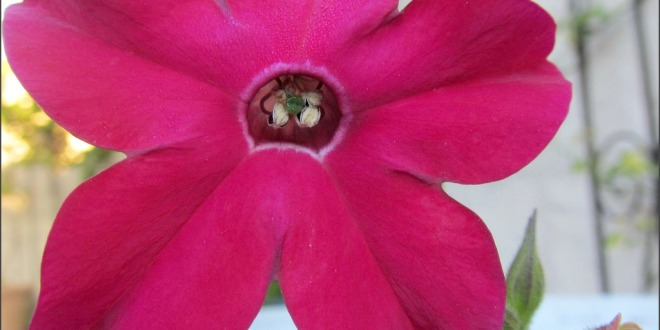Gardeners who enjoy growing Nicotiana, enjoy great, fragrant perfume. It’s a flower that is grown for it’s fragrance. Nicotiana attract hummingbirds to their trumpet shaped flowers.
Nicotiana plants are easy to grow. Flowers begin to appear and bloom in the early summer. The plant will rebloom all season. Flowers open up in late afternoon, and are on fragrant display all evening. Five pointed florets are trumpet shaped, with red, white, rose, pink, yellow, and lavender colors. Different varieties grow one to three feet tall, and produce flowers on slender stems.
Nicotiana looks good in mass plantings as bedding plants, or in clumps. You will want them to grow in groups, to enjoy their fragrance. They are best placed towards the middle of the flower garden. Try some on or near your patio or deck. Make sure to locate some under a window of your house. When the plants are in bloom, their fragrance can waft in through an open window. They can be grown in pots and containers, too.
Plants are native to warm tropical and sub-tropical areas of North and South America. Nicotiana is a member of the tobacco family.
Plant Height: 20″ – 24″
Important Note: Plants are poisonous , if swallowed. Keep away from children or pets.
”Plant
Nicotiana are grown from seeds. Nicotiana seeds can be directly seeded into your flower garden, or seeded indoors for transplanting later. An early, indoor start, translates into an earlier bloom. Sow seeds early in the season and cover lightly with 1/8″ or less of fine garden or seed starting soil.
Seeds germination period requires two to three weeks. For indoor starts, try a seedling germination mat.
Do not set out seedlings until after the last frost date your area. Plants are susceptible to frost. Ideal plant spacing is twelve inches apart.
Days to Germination: 7-14
”How
Nicotiana is easy to grow. Plants flower and bloom best in partial shade to full sun. Plants prefer a rich, well draining soils. Mix a healthy dose of compost into the soil prior to planting.
Plants like a lot of water and nutrients. While they like lots of water, they do not like wet soil. Keep soil moist, not wet. Add fertilizer when planting and every month during the season. Use a high phosphorous formula just before the first blooming period.
These plants have “sticky” leaves. Debris can be captured on the leaves and stick. It can be difficult to remove without damage to the leaves. Be careful when weeding or applying compost and mulch.
Nicotiana will begin to bloom in early summer. After each set of blooms, prune plants as needed. Pinch or deadhead spent flowers to promote reblooming.
Plants are annuals that are very susceptible to frost. Cover them up whenever cold temperatures are expected.
Nicotiana are good “re-seeders”. They will drop lots of tiny seeds for next year’s crop. Mark off the area, and allow new plants to grow in the spring. Do not disturb the soil until seedlings have begun to grow. Thinning will likely be needed.
Flowers Bloom: Through Summer
”Insect
Aphids, gnats, and other insects can pose a problem. Treat with insecticide or repellents, as needed.
Fungus diseases can occur. Use a general purpose fungicide in humid weather, and when problems appear.








